CAIE IG revision - Section 1 (2018)
如遇到公式加载异常,请刷新页面!
Section 1 The basic economic problem 基本经济问题
1.1 The nature of the economic problem 经济问题的本质
- 大纲要求
1.1.1 finite resources and unlimited wants 有限的资源与无限的愿望
• Definition and examples of the economic problem in the contexts of: consumers; workers; producers; and governments.
- Scarcity:稀缺性。resources资源在人们unlimited wants无限的愿望面前永远都是稀缺的,这是资源的固有属性(仅有很少的资源可以认为是不稀缺的)。
- Basic economic problem:基本经济问题,也称作fundamental economic problem或problem of scarcity,指finite resources有限的资源与人们unlimited wants无限的愿望之间的矛盾。
- 注意:needs是满足人们基本生活的需求,是有限的;而wants是提高人们生活质量的需求,是无限的。
- 由于资源具有稀缺性,稀缺的资源难以满足人们无限的愿望,因此人们需要在众多愿望中做出choices选择。
1.1.2 economic and free goods 经济产品与免费产品
• The difference between economic goods and free goods.
- Economic goods:经济产品,指具有scarcity稀缺性的产品,产品的获得有opportunity cost机会成本。
- 注意:现实中绝大多数的商品都是economic goods。
- Free goods:免费产品,指可以unlimited supply无限供应的产品,产品没有scarcity稀缺性,产品的获得是没有opportunity cost机会成本的。
- 注意:考试中出现过的典型free goods包括sea water海水、air空气、sunlight阳光、rainfall降雨、wild grass野草。基本都是自然界的物质。
1.2 The factors of production 生产要素
- 大纲要求
1.2.1 definitions of the factors of production and their rewards 生产要素的定义与回报
• Definitions and examples of land, labour, capital and enterprise.
• Examples of the nature of each factor of production.
- Factors of production:生产要素,指用来生产商品与服务的各类投入与手段。主要分为以下四类:
- Land:自然资源。各种自然资源全部包括在内(不仅仅只有土地),比如矿产、土壤、植物、动物等等,自然界的阳光、沙子、水、气候等等也属于该类。
- 自然资源分为renewable resource可再生资源和non-renewable resource不可再生资源。
- Labour:劳动力。主要是中低层劳动人民,如工人、技师。其数量与质量的多少取决于教育、培训training、文化限制cultural limitations、移民migration等等。
- Labour-intensive劳动力密集型企业,即成本中大部分为劳动力成本的企业。
- Capital:资本。指实体的机器、厂房、办公室、原材料、技术、道路、水电设施等,但不包括钱。
- Capital资本的分类:
- Working capital:最终可以体现在产品中的资本,主要指原材料。
- Fixed capital:帮助working capital变成最终产品的资本,主要指厂房、设备、办公室等。
- Capital-intensive资本密集型企业,即成本中大部分为资本成本的企业。
- Capital资本的分类:
- Enterprise:企业(或企业家),主要指组织生产并承担风险的个体,如高管、董事等,属于人力资本的一种。
- Roles of entrepreneur企业家职责:
- Organise the other factors of production to produce goods and services组织生产要素有效率生产(make decisions做决定)。
- Take risks承担风险。
- Roles of entrepreneur企业家职责:
- Land:自然资源。各种自然资源全部包括在内(不仅仅只有土地),比如矿产、土壤、植物、动物等等,自然界的阳光、沙子、水、气候等等也属于该类。
- 将自己拥有的生产要素投入生产后,会得到相应的回报。
- Land:rent 租金(或income收入)
- Labour:wage/salary/earnings 工资
- Capital:interest 利息(或rent租金)
- Enterprise:profit 利润
1.2.2 mobility of the factors of production 生产要素的可移动性
• The influences on the mobility of the various factors.
- Mobility:可移动性,指生产要素是否可以转移到其他生产过程中。可移动性主要分为以下两类:
- Geographical mobility:地域的可移动性,指生产要素可以从一个地点转移到另一个地点。
- Occupational mobility:职能的可移动性,指生产要素可以从一种功能转换为另一种功能。
- Land的可移动性分析:
- Land在地域上很难移动,无法从一个地方换到另一个地方(比如土地、湖泊等)。
- Land在功能上可以移动,可以从一种用途换为另一种用途(比如同一块土地,今年种玉米,明年放牛等)。
- Labour的可移动性分析:
- 一部分labour可以在地域和功能上进行移动,如换地点工作、更换不同类型的岗位等;但也有一部分人难以移动。
- Labour难以进行地域移动的原因:
- Differences in the price and availability of housing in different areas and countries. 不同国家和地区之间的商品价格及住房有差异,难以适应
- Family ties. 家庭纽带,不愿远离亲人
- Differences in educational systems in different areas and countries. 不同国家和地区之间教育体制存在差异,难以适应
- Lack of information. 信息缺失
- Restrictions on the movement of workers. 对工人流动的限制
- Labour难以进行功能移动的原因:
- A lack of information. 信息缺失
- A lack of appropriate skills and qualifications. 缺少相应的技能
- Capital的可移动性分析:
- Capital是否可移动,取决于其类别和形态。有些capital比较容易移动或更换功能(比如桌子),有些capital不容易移动或更换功能(如特殊用途的大型机械)。
- Enterprise的可移动性分析:
- 大部分的enterprise要素的可移动性较好,可能是四个生产要素中最容易移动的一个。因为企业家的管理技能较为通用,可以很好地在各家企业中进行转换,也接受去其他地方工作。但也有一些企业家不愿意更换地域。
1.2.3 quantity and quality of the factors of production 生产要素的数量和质量
• The causes of changes in the quantity and quality of the various factors.
- Land的数量:
- 一般来说,land的数量短时间内很难发生改变。
- 但soil erosion水土流失会导致农耕土地的减少;land reclamation填海造陆会增加土地面积;森林被破坏、资源过度开采等都可能改变land的数量。
- Land的质量:
- 可以通过使用fertiliser化肥、减少污染、使用更先进的drainage灌溉技术等方式提升land的质量。
- Labour的数量:
- 工人的人数和每人的working hours工作时长都能够影响到labour的数量。
- 影响工人人数的因素:
- The size of the population. 人口规模。人口越多,labour越多。
- The age structure of the population. 年龄结构。青年人和中年人越多,labour越多。
- The retirement age. 退休年龄。退休年龄越晚,labour越多。
- The school leaving age. 离开学校的年龄越早,labour越多。
- Attitude to working women. 对职业女性的态度。职场歧视越少,labour越多。(除gender discrimination性别歧视外,劳动力市场中还包括age discrimination年龄歧视、ethnical discrimination种族歧视等)。
- 影响工作时长的因素:
- The length of the average working day. 平均的工作日长度。工作日越多,工作时长越长。
- Whether they work full or part-time. 是否全职。全职工作,则工作时长越长。
- The duration of overtime. 加班情况。加班越多,工作时长越长。
- The length of holidays taken by workers. 假期长度。假期越短,工作时长越长。
- The amount of time lost through sickness and illness. 因病休养时长。病假越短,工作时长越长。
- Labour的质量:
- better education更好的教育,会提升劳动力素质。
- better training更好的培训,会提升劳动力素质。
- more experience更多经验,会提升劳动力素质。
- better healthcare更好的医疗,会提升劳动力素质。
- Capital的数量:
- 主要与investment投资情况有关,投资越多,capital越多。
- 也与time时间有关,随着时间的增加,capital也会逐渐积累起来,不断增加。
- Capital的质量:
- Technology技术的进步,会提升capital的质量。
- Enterprise的数量:
- better education更好的教育,培养出更多商业人才
- lower taxes低税收,鼓励人们创业
- reduction in government regulations减少政府法规限制,鼓励人们创业
- Enterprise的质量:
- Better education更好的教育,能够提升高管素质。
- better training更好的培训,能够提升高管素质。
- better healthcare更好的医疗,能够提升高管素质。
- more experience更多经验,能够提升高管素质。
1.3 Opportunity cost 机会成本
- 大纲要求
1.3.1 definition of opportunity cost 机会成本的定义
• Definition and examples of opportunity cost in different contexts.
- Opportunity cost:机会成本,指的是对所有可能的choices进行排序,在选择了一个最优选择后,放弃掉的次优选择(next best alternative)的价值。
- 比如鱼和熊掌不可兼得,如果选择鱼,则熊掌的价值就是选择鱼的机会成本。
1.3.2 the influence of opportunity cost on decision making 机会成本对决策的影响
• Decisions made by consumers, workers, producers and governments when allocating their resources.
- Consumers消费者需要在自己想购买的商品中做出选择。
- Workers工人需要在自己想从事的岗位中做出选择。
- Producers生产者需要在想生产的产品中做出选择。
- Government政府需要在想改善的经济目标中做出选择(如教育、医疗、交通等)。
1.4 Production possibility curve (PPC) diagrams 生产可能性曲线
- 大纲要求
1.4.1 definition of PPC PPC的定义
• Definition, drawing and interpretation of appropriate diagrams.
- Production possibility curve生产可能性曲线(PPC):指一个经济体用尽当前全部资源all of the current resources,能够生产出来的最大产出(maximum output)。
- 别称:production possibility frontier(PPF)生产可能性边界。
- 生产可能性曲线的常见图像
- 注意:两坐标轴名称通常为两种商品,如果没有指定商品,可用capital goods资本品和consumer goods消费品,或者Good A和Good B。
- 线上的每一点代表着如果用尽当前资源可生产的两种产品的组合情况combinations。如下图A点代表用尽当前资源可生产700辆车和1200台电视,B点代表用尽当前资源可生产500辆车和1500台电视。
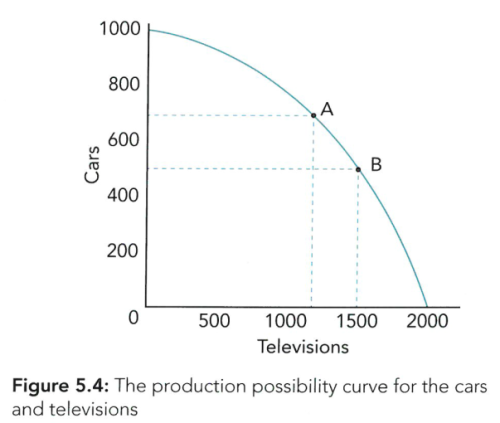
- PPC与opportunity cost
- PPC中的opportunity cost表现为随着A产品产量增加,B产品产量下降。B产品下降损失的价值即为增加A产品生产的机会成本。
- 随着A产品上升,opportunity cost保持不变constant的时候,PPC呈一条直线。
- 这是由于生产要素在两种商品间没有偏向性be equally suited,被平等地消耗。
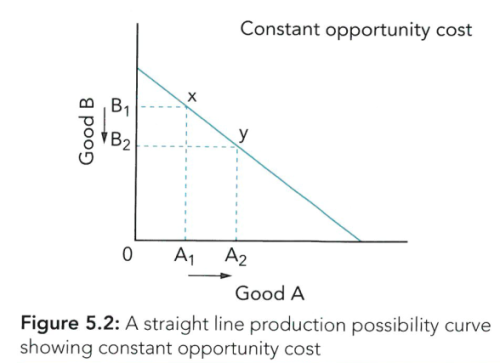
- 随着A产品上升,opportunity cost持续上升increasing的时候,PPC呈一条拱形convex to the origin/be curved outwards的曲线。
- 这是因为生产要素对两种商品的生产有偏向性,随着A商品产量增加,适合B生产的生产要素不断被夺走,造成B商品损失的收益越来越多。
- 随着A产品上升,opportunity cost持续上升increasing的时候,PPC呈一条拱形convex to the origin/be curved outwards的曲线。
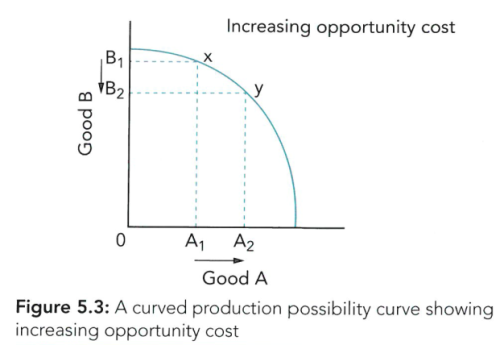
1.4.2 points under, on and beyond a PPC 点在PPC线里、线上和线外
• The significance of the location of production points.
- PPC线内、线上、线外各点的经济含义
- 线内(C):低于最大产出below maximum output、生产无效率productive inefficiency。
- 线上(A、B):最大产出maximum output、生产效率productive efficiency。(所有点都满足,无论位置)
- 线外(D):当前生产水平达不到该产出,资源稀缺scarcity。(注意是当前达不到,而不是永远达不到。随着PPC外扩,未来可能会达到该点。)
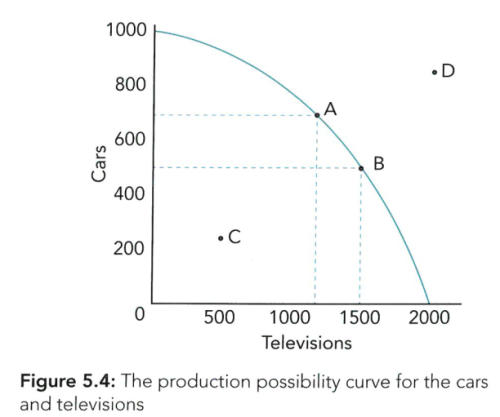
1.4.3 movements along a PPC 点沿着PPC移动
• Movements along a PPC and opportunity cost.
- Movement:点沿着线移动
- 原因:资源在两种商品间的再分配resource reallocation。下图中从A到B的移动表示资源从A转移了一部分到B,从而少了一些车,多了一些电视。
- 点移动后的数量上升为expansion,下降为contraction。

1.4.4 shifts in a PPC 整条PPC移动
• The causes and consequences of shifts in a PPC in terms of an economy’s growth.
- Shift:整条线的移动
- PPC的线整体外移shift outwards/rightwards原因:经济增长,包括生产要素数量增加和质量提升。
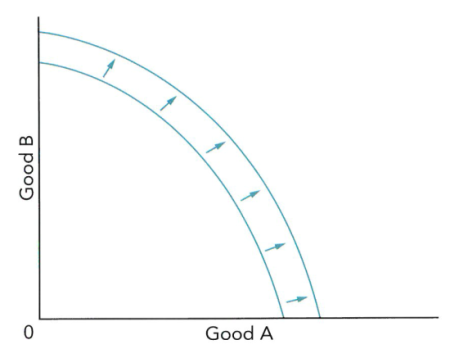
- PPC的线整体内移shift inwards/leftwards原因:经济衰退(主要是长期衰退。短期衰退可表现为点移到PPC内部)
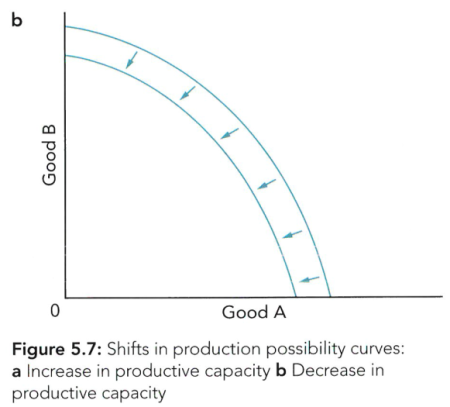
- Pivot:线围绕一点发生旋转移动
- 单商品pivot移动原因:仅生产该商品的某些生产要素发生变动。如下图PPC1旋转变动到PPC2,可能是电视的生产技术进步、制造电视的工人增加、电视原材料供应增加等。
- 旋转移动的方向:pivot inwards向内(数量下降)/outwards向外(数量上升)。




